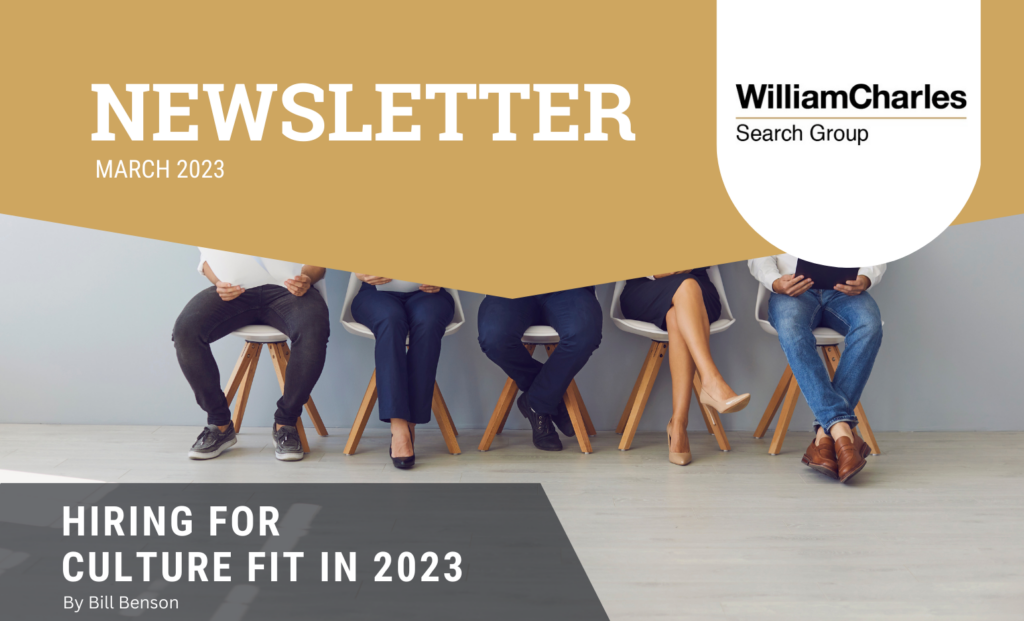
Hiring for Culture Fit in 2023 by Bill Benson
Are you struggling to find people who will stay with you long term? Do you have an intentional process to evaluate fit? We still see companies screening and measuring candidates against largely tangible requirements. Most companies see the importance of culture fit, but it hasn’t translated to the interview process. A best practice would be to evaluate both tangible and intangible qualities. If someone fails or leaves after a short time it is often related to how they fit within the company or some other intangible factor. Hiring an employee that fits well with the team and has a baseline of experience to build from is often a better hire than someone who has all the experience but doesn’t fit the company well.
It is easy to attach confidence to a candidate with parallel experience or be infatuated with a specific aspect like a skill set or competitor experience. Many of the factors we see as important are often skills that can be learned. Personality, drive, character, willingness to change, interest in learning and many other factors are inherent and won’t change.
The most discussed aspect of fit is “culture fit.” Culture fit refers to the compatibility of an individual with a company’s values, beliefs, and working style. The idea behind hiring for culture fit is that employees who share the company’s culture are more likely to be happy, productive, and stay with the company longer.
Consider employees within your company who are succeeding. What are the qualities they possess that make them successful? They have a good understanding of what it takes to be successful in your organization. It’s important to take a good look at the factors pivotal to the success of your top employees. This gives you insight on qualities to seek with your new hires.
When considering culture fit in the hiring process employers typically assess an applicant’s values, communication style, work ethic, and personality. This can be done through various methods such as:
Interviews: The interviewer can ask open-ended questions such as, “describe a culture that is a good fit for you?” “What elements or characteristics are you seeking in your next work environment?” “If you could wave a magic wand – what would you change in your current environment?” Here are some additional questions to consider.
References: Speaking to the candidate’s past colleagues or managers can provide insights into their work ethic and how they fit into a team.
Behavioral and situational interview questions: These types of questions can provide insight into how the candidate might handle different scenarios in the workplace.
Work samples and tests: Review a candidate’s previous work or give them a test or project that can give a clearer idea of their skills and abilities, as well as their approach to problem-solving.
Company events and activities: Inviting candidates to company events or activities can give them a sense of the company culture and help determine if they would be a good fit. Having the potential candidate spend some time in your environment will also give you a feel for how they fit.
Dinner or lunch: Having a candidate out with a small group in an informal setting like dinner or lunch will give you insight into their social skills.
Family-owned businesses have unique challenges and opportunities when it comes to hiring and building a successful workforce. Typically, these companies have strong cultures that value people, customers, relationships and teamwork. In the post covid environment, many of these family business values resonate with employees looking for stability in a caring environment. It is critical for these culture rich environments to take extra time to evaluate alignment. Here are a couple of tips for family businesses leaders:
- Designate a key family member who has strong alignment and passion for the culture of the organization and involve them in the interview process.
- Have a clear understanding of the elements that make up your culture and use those to help promote your brand. Elements like a focus on safety or employee development are examples that reinforce an environment that is meeting the needs of its employees.
- Trusting relationships are developed when the employee believes the employer is focused on collective interests rather than profit. Make sure interviews are a two-way street where you ask questions about what is important to the candidate and what is important to you.
- Develop purposeful opportunities for employees to volunteer and get involved with a community or not-for-profit organization. These activities will reinforce your culture of caring.
Here are some areas of “fit” to check that can contribute to an employee’s success:
1. Readiness to adapt and change
2. Self-Directed
3. Motivation and Drive
4. Values Alignment
5. Interest in Learning – Creative, Inquisitive
6. Capability to Work Collaboratively
7. Emotional Intelligence
8. Pro-Active – Able to “see the work” as well as execute.
9. Leadership Style
10. Character and Integrity
The cost of a hiring mistake can be 3-5 times the amount of the employee’s annual salary. A good interview, reference and assessment process will help you find a great fit for your organization.
Happy Employee Hunting!
